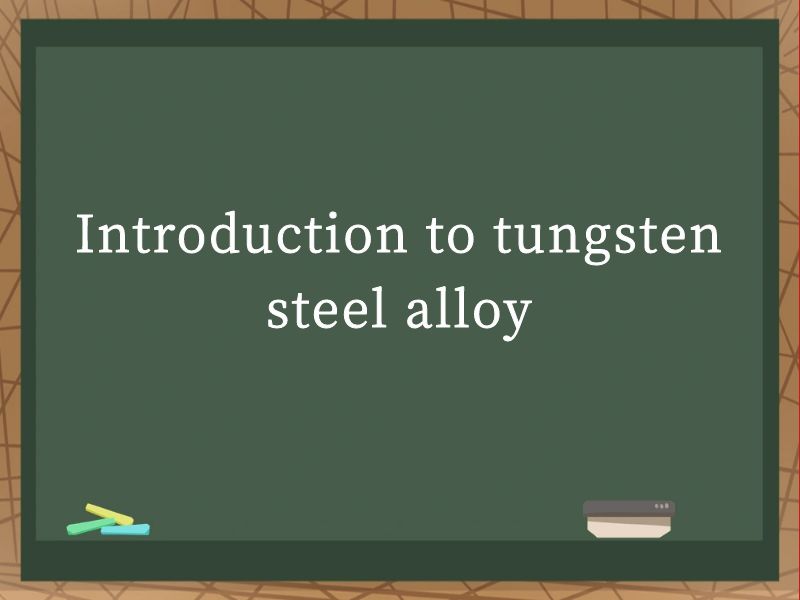JOURNALISM
- NEWS -
|
Introduction to tungsten steel alloyIntroduction to tungsten steel alloy.Tungsten steel alloy, a remarkable material known for its exceptional hardness and wear resistance, has become an indispensable component in various industrial applications. This alloy, a combination of tungsten and other elements, offers unique properties that make it suitable for use in extreme conditions where conventional metals might fail.
Tungsten, chemically represented as W, is a rare metal with a very high melting point and exceptional hardness. When alloyed with other metals such as cobalt or carbon, it forms a material that is both hard and resistant to wear, making it ideal for cutting tools, drill bits, and other industrial implements. The properties of tungsten steel alloy are numerous and impressive. Firstly, its hardness ensures that tools made from this material maintain their sharpness and durability even after extended use. This hardness, combined with its wear resistance, significantly extends the lifespan of the tools, reducing the frequency of replacements and maintenance costs. Furthermore, tungsten steel alloy exhibits excellent corrosion resistance. This means that tools and components made from this alloy can withstand exposure to harsh environments, including moisture, chemicals, and extreme temperatures, without suffering significant damage or deterioration. The manufacturing process of tungsten steel alloy involves precise control over the composition and heat treatment of the material. Tungsten is typically combined with carbon and other alloying elements like cobalt or chromium to enhance its mechanical properties. The resulting alloy undergoes a series of heat treatments to achieve the desired hardness and durability. One of the key applications of tungsten steel alloy is in the manufacturing of cutting tools. Due to its hardness and wear resistance, it is an ideal material for making drill bits, milling cutters, and lathe tools. These tools are widely used in the machining of metals, plastics, and other materials. Tungsten steel alloy is also commonly used in the production of punches, dies, and other tooling components in the metal stamping and forming industry. Its durability and hardness allow it to withstand the repeated impact and pressure associated with these applications. Additionally, this alloy finds its place in the mining industry, where its strength and wear resistance are crucial for drill bits and other mining tools that encounter hard and abrasive materials. Beyond its industrial applications, tungsten steel alloy also plays a role in the medical field. Surgical instruments made from this material offer precision cutting and durability, essential for delicate surgical procedures. The benefits of using tungsten steel alloy are numerous. Its longevity reduces the frequency of tool replacements, saving both time and money. Its corrosion resistance ensures reliable performance in hostile environments. Moreover, its hardness and durability allow for precise and efficient cutting, drilling, or stamping operations. However, tungsten steel alloy also has its limitations. Its high hardness makes it difficult to machine or grind, requiring specialized equipment and skilled operators. Additionally, the material's cost can be higher compared to some conventional metals, making it less suitable for large-scale, low-cost production. Despite these challenges, tungsten steel alloy remains a preferred material in many specialized applications. Its unique combination of hardness, wear resistance, and corrosion resistance makes it invaluable in industries where durability and precision are paramount. The future of tungsten steel alloy looks promising. With advancements in material science and manufacturing technologies, we can expect even more refined and specialized versions of this alloy to emerge. Its properties might be further enhanced through the addition of new alloying elements or innovative heat treatment processes. Moreover, as sustainability becomes a growing concern across industries, tungsten steel alloy's durability and longevity align with the need to reduce waste and increase the lifespan of products. This could potentially lead to a wider adoption of this material, especially in applications where frequent replacements are costly and environmentally unfriendly. In conclusion, tungsten steel alloy is a remarkable material that offers exceptional hardness, wear resistance, and corrosion resistance. Its unique properties make it an indispensable component in various industrial applications, from cutting tools and punches to surgical instruments. While it has its limitations, such as machining difficulty and higher cost, its benefits outweigh these challenges in many specialized uses. As material science advances, we can expect tungsten steel alloy to evolve and find even more applications in the future. |


